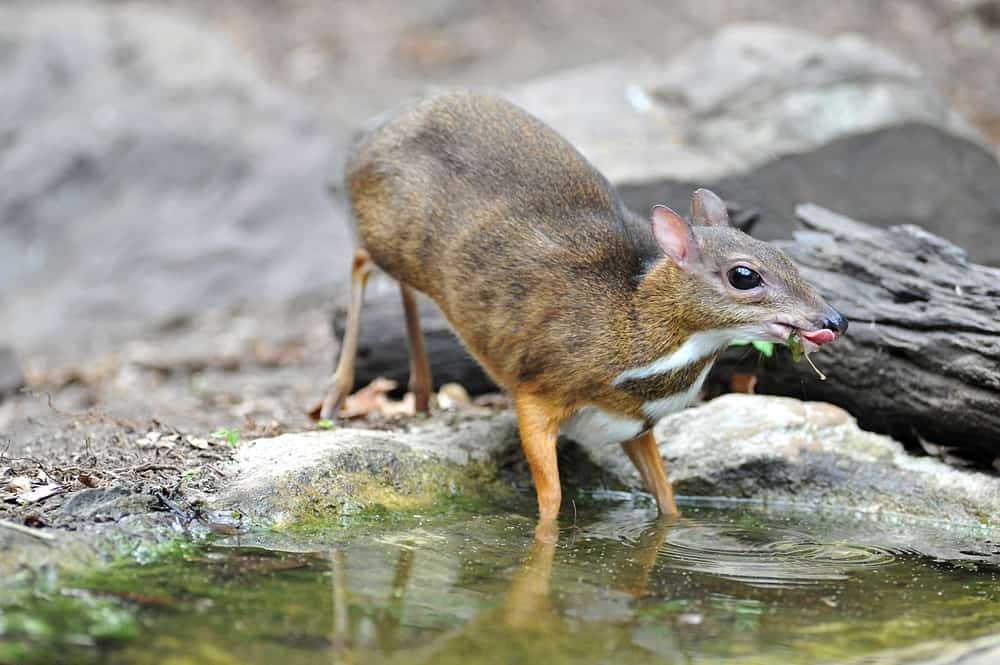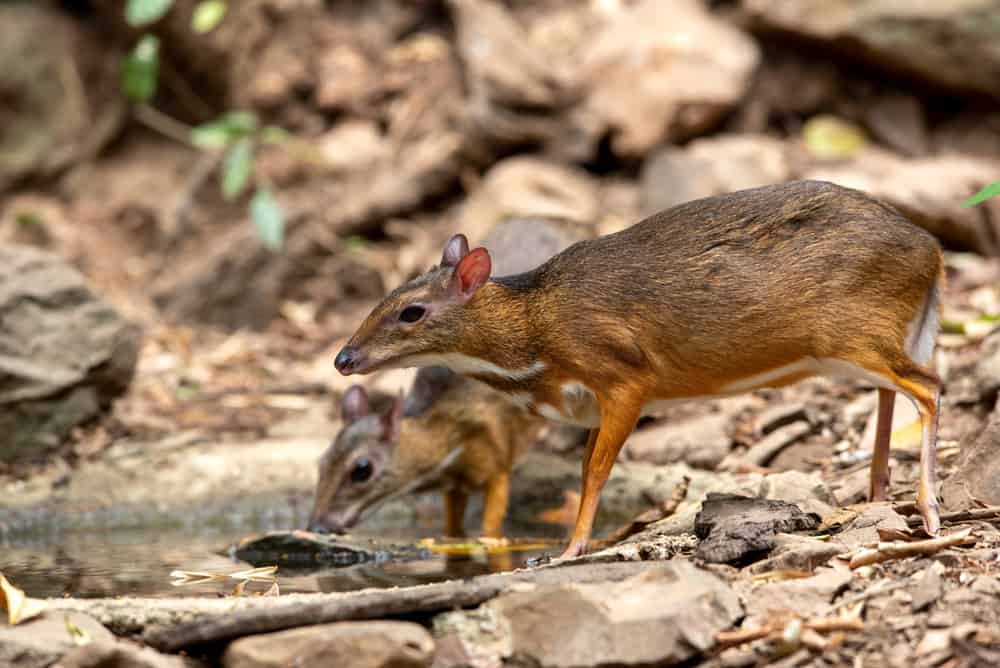The water chevrotain, also known as the Vietnamese mouse-deer (Hyemoschus aquaticus), is a small species of ungulate native to Southeast Asia.
It was first discovered in 1910 and has since become an iconic symbol of the region’s biodiversity.
Despite its notoriety, however, very little research has been conducted on this enigmatic creature due largely to its elusive nature and restricted range.
As a result, it remains one of the least studied large mammals in the world.
This article will provide an overview of what we currently know about water chevrotains, focusing on their biology, ecology, habitat requirements and conservation status.
In addition, current initiatives to protect them from further decline will be discussed.
Finally, potential avenues for future research into this poorly understood species will be suggested.

Overview Of The Water Chevrotain
The water chevrotain, also known as the ‘mouse deer,’ is a small mammal found in some parts of Southeast Asia and Africa. It’s one of the lesser-known members of its family and often overlooked due to its diminutive size. Despite this, it has quite an interesting biology and lifestyle that makes it fascinating for zoologists and naturalists alike.
Breeding habits are particularly intriguing; mating rituals involve several males competing for dominance with females usually choosing just one winner from these contests. Males will typically fight each other by using their horns or antlers to establish hierarchy before proceeding with copulation attempts.
Females on the other hand tend to be more passive during courtship but still have a say when selecting which male they’d prefer based on physical appearance, scent, behavior, etc. As such, understanding how this species’ breeding process works helps us gain insights into why animals may choose certain partners over others.
All in all, there is much to learn about this remarkable creature and hopefully continued research can lead to further discoveries.
Habitat Requirements And Distribution
The water chevrotain, also known as the Vietnamese mouse-deer, is an elusive species native to southern Vietnam and Cambodia.
It has long been believed that its habitat requirements are wide ranging enough for it to be found in many different ecosystems throughout Southeast Asia; however, recent studies have revealed this is not necessarily the case.
Breeding behaviors and mating rituals of the species have been observed primarily in areas with permanent bodies of water like swamps or wetlands – suggesting a dependence on these environments for survival.
In order to get a better understanding of the specific habitats required by this species, researchers set out to observe them in their natural environment.
The results showed that while they can survive outside of wetland areas temporarily during dry seasons, they rely heavily on access to consistent sources of freshwater year round.
These findings support previous research which suggests that any changes in land use patterns near these regions could lead to dramatic decreases in population sizes due to loss of suitable habitats.
Biology And Behavior
The water chevrotain, a semi-aquatic mammal found in tropical wetlands and rivers of Africa, is known for its unique biology and behavior. From their breeding habits to social interaction, this remarkable species exhibits fascinating traits that set them apart from other mammals.
Though they are solitary creatures most of the time, here are some ways the water chevrotain stands out:
- Breeding Behavior: Water chevrotains breed year round with males typically being polygamous – mating with multiple females over a span of months.
- Social Interaction: These animals can be quite territorial when it comes to finding food or defending themselves against predators. In addition, mother chevrotains have been observed caring for their young and even engaging in play activities!
- Adaptability: The ability to survive both on land and in the water makes these small mammals incredibly adaptable to different environments.
From aquatic habitats to grassy plains, the water chevrotain has managed to thrive despite various environmental changes throughout its range — an impressive feat indeed!
Feeding And Diet
Water chevrotains, also known as mouse-deer, are small and unique animals that inhabit tropical regions of Asia. They have a variety of dietary needs which are met through foraging habits in their natural environment.
The water chevrotain’s diet consists mainly of fruits, leaves, insects, snails and other invertebrates. In addition to this varied menu, they occasionally supplement with aquatic plants or algae found near the edges of bodies of water such as streams or rivers.
It is most common for water chevrotains to feed during twilight hours just before dawn and again at dusk when temperatures are cooler but still provide adequate light levels. During these times, it is not uncommon for them to travel up to one kilometre away from their home range in search of food sources. Therefore, access to a large enough area with ample resources is an essential component in maintaining healthy populations.
With careful management practices and increased conservation efforts, the future of this species may be secured against further decline due to habitat destruction or fragmentation. By protecting its native habitats and providing sufficient resources within those areas, we can ensure the continued survival of this animal well into the future.
Predators And Threats
The water chevrotain, an aquatic species of mouse-deer found mainly in the wetlands of South and Southeast Asia, has a unique adaptation that sets it apart from its terrestrial relatives. Not only is it able to survive in both forested as well as marshy habitats, but this small mammal also possesses remarkable skills for predator avoidance.
As such, their populations are threatened by humans hunting them for food or sport and have been decimated over time due to habitat loss caused by land conversion for agriculture.
In addition to threats posed by human hunters and habitat destruction, water chevrotains face further risks due to disease transmission. With their population significantly reduced and fragmented due to human activities, they become more vulnerable to diseases spread through contact with other animals or with contaminated water sources.
Moreover, these diseases can be difficult to detect until it’s too late since they often show no symptoms at first before progressing into fatal illnesses. Conservation efforts must thus focus on preventing any additional fragmentation of already existing populations while making sure that all potential vectors of disease transmission are identified and eliminated where possible.
Conservation Status And Initiatives
The water chevrotain is listed as vulnerable by the International Union for Conservation of Nature due to its declining population. Its range has become increasingly fragmented, largely in part to deforestation and hunting activities.
This decline puts a strain on already endangered populations, making conservation strategies a priority for many organizations and governments.
Though there are still large gaps in knowledge regarding the species’ ecology and behavior, multiple initiatives have been launched to help conserve it from further decline.
Currently, these include habitat protection, anti-hunting enforcement, awareness campaigns, captive breeding programs and reintroduction projects into suitable habitats with strict monitoring protocols.
These efforts have seen some success but more work needs to be done if we want this species to survive the increasing pressures that human activity brings upon it.
Challenges To Conservation
The conservation of water chevrotains has been a pressing issue for some time, but what challenges must be tackled in order to ensure their long-term survival? Climate change and increasing human encroachment are the primary issues facing these small deer-like animals.
How can we protect this unique species from extinction? Here are four key steps that should be taken:
- Establishing protected reserves across their range
- Developing sustainable agricultural practices in affected areas
- Creating buffer zones between natural habitats and urban or rural development
- Reducing environmental pollutants through improved waste management techniques
These measures will go a long way towards preserving suitable habitat for water chevrotain populations, while at the same time providing them with ample food sources and reducing conflict with humans who share their environment.
However, it is also essential that local communities become engaged in conservation efforts if meaningful progress is to be made in the fight against climate change and other threats posed by human activity.
Ultimately, only through concerted effort on many fronts – such as education, policymaking, and research – can we hope to secure a future for this incredible species.

Future Research Directions
Water chevrotain is a small, elusive species of ungulate found in the wetlands and forests of West Africa. Although their population size is currently unknown due to difficulties with surveying, there has been considerable research into understanding its ecology and behavior.
Future research should focus on developing an accurate estimation of water chevrotain populations as well as providing insight into population dynamics such as density dependence and range expansion/contraction rates. Additionally, further research should be conducted regarding poaching prevention efforts for this species. Given the high levels of hunting pressure that it faces throughout its range, conservation measures will need to be implemented in order to ensure its survival.
It is also important that any future research consider how current human activities such as deforestation or overharvesting may affect the viability of local populations. By identifying potential threats and evaluating their impact on the survivability of water chevrotains, effective management plans can be put in place to reduce risk factors while simultaneously promoting sustainable use of resources within their habitats.
Ultimately, more information about this species’ ecological requirements will help inform better protection strategies aimed at ensuring long-term persistence of healthy populations across West Africa.
Conclusion
The water chevrotain is a unique species that requires specialized habitat, diet and behavior to survive.
Despite the challenges it faces from predators, human disturbance and environmental changes, conservation efforts have been made in some parts of its range to ensure its future.
These initiatives must be continued if we are to preserve this important part of our planet’s biodiversity.
Moreover, further research into the ecology, behaviour and genetics of the water chevrotain will provide us with invaluable information for effective conservation management.
Thus, an ongoing commitment is essential; only then can we safeguard this remarkable creature for future generations.

